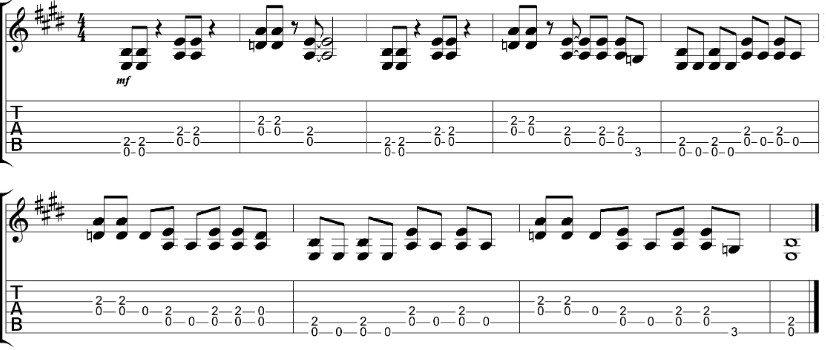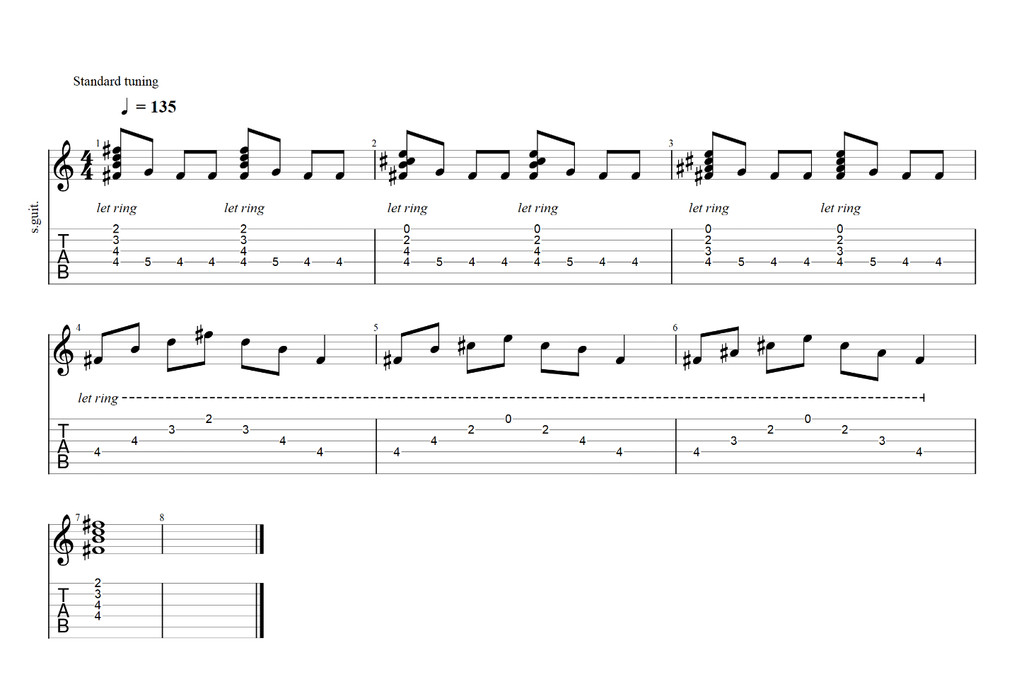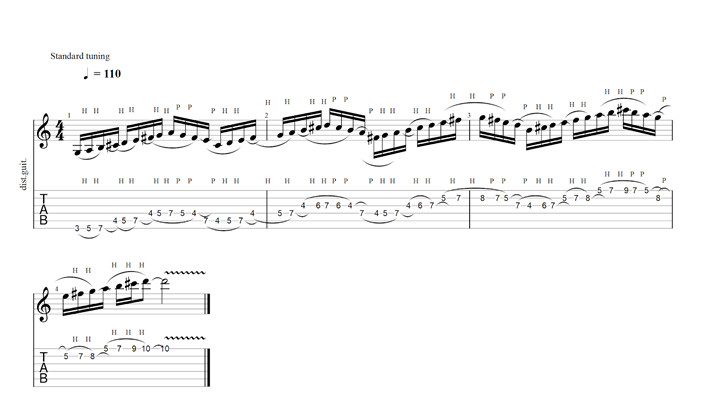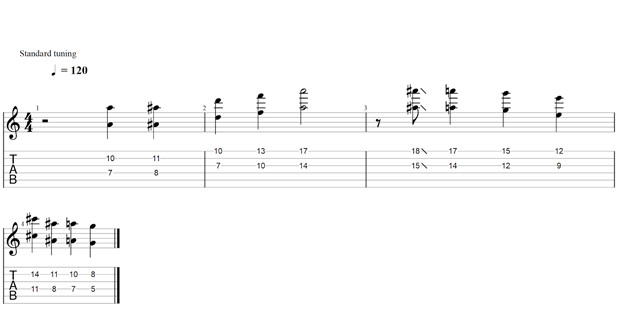Welcome back to guitarplayers.net, your ultimate destination for all things guitar! Today, we’re diving deep into the world of guitar music to demystify two fundamental concepts that often puzzle aspiring musicians: Guitar Riffs and licks. It’s surprising how many guitar enthusiasts struggle to differentiate these terms, but understanding their distinct roles is crucial for both playing and songwriting.
If you’ve ever felt confused by riffs and licks, don’t worry – you’re definitely not alone. However, grasping the nuances between these two musical building blocks will significantly enhance your musical vocabulary and empower you to create more compelling and effective guitar parts in your own music.
That’s precisely why we’re here to set the record straight and provide a comprehensive guide to understanding guitar riffs and licks, ensuring you can confidently identify and utilize them in your playing.
 Guitarist playing a powerful riff on an electric guitar
Guitarist playing a powerful riff on an electric guitar
Throughout this lesson, we’ll explore iconic guitar riffs and licks, providing tablature examples to get you playing right away. To truly appreciate their impact, I strongly encourage you to seek out recordings and videos of the original songs. Hearing them in context will give you a deeper understanding of their feel and stylistic contribution.
So, let’s plug in and embark on a sonic journey to definitively distinguish between guitar riffs and licks, unlocking a new dimension in your guitar playing.
What Exactly is a Guitar Riff?
Let’s cut to the chase. A guitar riff is the DNA of a song. It’s a short, repeated musical phrase or pattern that serves as the song’s central musical idea and often its most recognizable hook. Think of it as a sonic signature that instantly identifies a song. Guitar riffs are typically introduced early in a song, often in the intro, and they establish the song’s mood, energy, and overall character.
Remember the electrifying intro to Guns N’ Roses’ “Sweet Child O’ Mine”? That instantly recognizable melodic phrase is a prime example of a guitar riff. It’s not just an intro; it’s the song’s identity, etched into the minds of millions of listeners worldwide. This is the power of a truly iconic guitar riff.
 Close-up of guitar fretboard showing fingers playing a riff
Close-up of guitar fretboard showing fingers playing a riff
The Importance of Guitar Riffs: Why They Matter
A well-crafted guitar riff elevates a song from simple to unforgettable. It’s the hook that grabs listeners and keeps them coming back for more. This central theme remains consistent throughout the song; it’s not improvised or drastically altered because its purpose is to anchor the listener and define the musical landscape they’ve entered.
Imagine trying to play Led Zeppelin’s “Stairway to Heaven” with a different opening – it simply wouldn’t be “Stairway to Heaven.” The opening riff is the song’s essence, its soul. Similarly, removing the iconic, ominous riff from Deep Purple’s “Smoke on the Water” would instantly strip the song of its power and recognition.
Guitarists across genres have harnessed their creativity to forge riffs that have not only topped charts but have also become timeless classics, resonating with generations of music lovers.
Must-Know Guitar Riffs: A Starting Point
To give you a taste of riff greatness, here are some essential riffs every guitarist should explore:
- “Voodoo Child (Slight Return)” – Jimi Hendrix (A masterclass in psychedelic blues-rock riffing)
- “Beat It” – Michael Jackson (Eddie Van Halen’s iconic contribution to pop)
- “Seven Nation Army” – The White Stripes (Simplicity and impact at its finest)
- “Satisfaction” – The Rolling Stones (Fuzz-toned and undeniably catchy)
- “Paranoid” – Black Sabbath (The blueprint for heavy metal riffs)
- “Whole Lotta Love” – Led Zeppelin (Blues-infused rock riff with raw power)
- “Smells Like Teen Spirit” – Nirvana (Grunge anthem with a riff that defined a generation)
- “Back in Black” – AC/DC (Pure rock and roll energy in riff form)
- “Sweet Child o’ Mine” – Guns N’ Roses (Melodic and instantly recognizable)
- “Iron Man” – Black Sabbath (Heavy, slow, and utterly iconic)
This is just a starting point, and we’ll delve into more examples later.
Riffs in Summary: The Song’s Foundation
Hopefully, you’re beginning to grasp the significance of a guitar riff. It’s more than just a musical phrase; it’s the backbone, the identity, and often the most memorable part of a song. While commonly found in intros, riffs can appear throughout a song to reinforce the main theme and add impact.
When crafting your own songs, think about creating a strong, defining riff. It should be a concise musical statement that elevates your song and sets it apart. Don’t feel pressured to improvise on a riff; its strength lies in its repetition and consistency. No one would suggest improvising over the “Satisfaction” riff – it’s perfect as it is!
Now, let’s shift our focus to guitar licks and uncover how they differ from these foundational riffs.
What is a Guitar Lick? Adding Spice and Flair
No, we’re not talking about literally licking your guitar! While some rockstars might do that for showmanship, a guitar lick in musical terms is something entirely different. Unlike a guitar riff, which is a song’s fixed, defining musical phrase, a guitar lick is a short, melodic phrase or pattern, often improvised or used as a decorative flourish within a song, particularly during solos.
Think of licks as short bursts of musical flavor. They are often interchangeable with terms like “guitar fills,” “runs,” or even “solos” in a broader sense. The key characteristic of a lick is its variability; it’s meant to be adapted, improvised upon, and injected with personal style.
 Guitarist performing a fast, intricate lick during a solo
Guitarist performing a fast, intricate lick during a solo
The Purpose of Licks: Expressing Musicality
Guitarists often use licks to add excitement and personal expression, especially during guitar solos. In live performances, the urge to improvise and add unique touches is amplified. Guitarists might alter existing solos, insert short, impactful phrases, or create something entirely new on the spot. These spontaneous musical ideas are essentially improvisational licks.
However, it’s important to note that not every improvisation is a lick. A true guitar lick is a crafted musical idea, designed for repeated use, but with the flexibility to be slightly altered and adapted across different songs or performances.
A guitarist might modify a lick by adding or removing notes, changing the rhythm, or altering other aspects to fit the musical context. Because licks are structured and have a defined character, they can be learned, practiced, and incorporated into your playing to enhance your solos and fills with extra flair and personality. Mastering licks is a great way to inject your solos with memorability and impact.
In the following sections, we’ll explore classic examples of both riffs and licks to solidify your understanding of their differences and how they are used in music. Remember the crucial distinction: riffs are generally fixed and foundational, while licks are designed to be flexible and expressive.
Riff vs. Lick: Key Differences Summarized
To ensure absolute clarity, let’s reiterate the core differences between guitar riffs and licks, especially if you jumped straight to this section!
As we established, a riff is a unique, repeated, and attention-grabbing musical phrase. It’s the musical hook that defines a song through its rhythm, melody, or harmony. Riffs can appear anywhere in a song, but are commonly featured in introductions to immediately establish the song’s identity. A successful riff is instantly memorable and resonates deeply with listeners.
On the other hand, a lick is a shorter, more flexible musical idea. Guitarists use licks to add spice, variation, and personal expression to a song, often during solos or fills. Licks are designed to be adaptable and improvisational.
 Infographic comparing and contrasting guitar riffs and licks
Infographic comparing and contrasting guitar riffs and licks
A riff stands alone as a complete musical statement. Playing the intro riff to Metallica’s “Nothing Else Matters” is musically satisfying even in isolation. The same cannot be said for a lick. A lick played in isolation often sounds incomplete, abrupt, and lacks context.
While riffs can be adapted for various instruments, licks are generally guitar-specific and showcase instrumental virtuosity. Riffs set the overall vibe and foundation of a song, whereas licks are used to highlight a guitarist’s skill and add dynamic interest, often through solos or improvisations over a song’s melodic framework.
Riffs are designed for lasting memorability, becoming synonymous with a song. Licks, while impactful in the moment, might not have the same long-term staying power as a song-defining riff.
Analogy: Think of baking a cake. The icing is like the riff – it’s the defining visual and flavorful element, making the cake unique and essential to its identity. Sprinkles or other decorative elements are like licks – they add visual interest and flair, but are not fundamental to the cake’s core flavor or structure.
The most significant difference remains improvisation. Licks are inherently more improvisational and adaptable. Riffs are typically integral to a song’s composition and are not spontaneously improvised.
Guitar Riffs vs. Licks: A Side-by-Side Comparison
[Insert Infographic Image Here – if available from original, recreate if not or describe features]
15 Must-Listen Guitar Riffs: Expand Your Riff Repertoire
Earlier, we touched upon some iconic riffs. Now, let’s expand that list with 15 more exceptional guitar riffs that every aspiring guitarist should hear and draw inspiration from. Many of these are considered among the greatest guitar riffs of all time (picture_freelance, 2012), making them essential listening for any guitarist seeking to understand the power of a great riff.
Try listening to each song and then imagine it without its riff. This exercise will vividly demonstrate just how crucial the riff is to each song’s identity and impact. Get ready to discover some new favorites and add essential tracks to your playlist!
 Collage of album covers featuring bands known for great guitar riffs
Collage of album covers featuring bands known for great guitar riffs
Note: This list is in no particular order.
- “Brianstorm” – Arctic Monkeys (Modern indie rock riff with driving energy)
- “Johnny B. Goode” – Chuck Berry (Rock and roll classic, the quintessential early rock riff)
- “Paranoid” – Black Sabbath (Heavy metal blueprint, dark and ominous)
- “Sunshine of Your Love” – Cream (Psychedelic blues-rock with a memorable, wah-infused riff)
- “One” – Metallica (Thrash metal ballad with a powerful and emotive riff progression)
- “Back in Black” – AC/DC (Pure rock energy, often cited as the greatest riff ever)
- “Pretty Vacant” – Sex Pistols (Punk rock energy, simple but effective)
- “I Wanna Be Your Dog” – The Stooges (Proto-punk raw power and attitude)
- “I Can’t Explain” – The Who (Power chord driven, classic rock energy)
- “Cinnamon Girl” – Neil Young (Simple but hypnotic acoustic riff)
- “Don’t Cry” – Guns N’ Roses (Emotional ballad with a soaring, melodic riff)
- “Marquee Moon” – Television (Angular and innovative post-punk riff)
- “Get It On” – T. Rex (Glam rock swagger with a catchy, driving riff)
- “Alive” – Pearl Jam (Grunge anthem with a powerful and anthemic riff)
- “Smells Like Teen Spirit” – Nirvana (Grunge revolution in a riff, generation-defining)
Beginner-Friendly Guitar Riffs to Learn at Home
Now it’s your turn to get hands-on with riffs! Let’s move from listening to playing. In this section, we’ll explore some beginner-friendly guitar riffs that you can learn, practice, and even adapt for your own songs.
These riffs are designed to be accessible to guitarists at any level, even beginners. As long as you know basic chords and strumming, you should be able to tackle these riffs with some practice and enjoy immediate musical gratification.
Feel free to use these riffs as starting points for your own songwriting or modify them to fit your personal style. Experimentation is key to developing your own riff-writing skills!
 Beginner guitarist practicing riffs with tablature on a music stand
Beginner guitarist practicing riffs with tablature on a music stand
Power Chord Guitar Riff for Beginners
This riff utilizes power chords, a fundamental building block for rock and metal guitar. It’s a versatile pattern that can be adapted in numerous ways. Palm muting (dampening the strings with the side of your picking hand) adds a heavier, chunkier feel, which I highly recommend trying for this riff. If you’re unfamiliar with palm muting, there are many excellent online tutorials to get you started.
 Tablature for a beginner power chord guitar riff
Tablature for a beginner power chord guitar riff
This riff uses E5, A5, and D5 power chords. Try incorporating this riff into the chorus section of a song, ensuring the chord progression of your chorus complements the riff’s feel.
Funky Clean Guitar Riff for Rhythm Practice
Who doesn’t love a funky guitar riff? Funky riffs are infectious and groove-driven, but creating them can seem challenging. This riff provides a great starting point for exploring funk guitar rhythms. For this riff, try using your neck-hand thumb to fret the lower E string. This technique is common in funk and allows for convenient muting and rhythmic control.
This riff is designed to be repeated throughout the verses of a song, creating a rhythmic foundation.
 Tablature for a funky clean guitar riff
Tablature for a funky clean guitar riff
Transpose this riff to G for the subsequent bars to create variation. Use these patterns in your verses and experiment with modifications to create your own funky variations within your songs.
Beginner Acoustic Guitar Riff
Acoustic guitarists, we haven’t forgotten you! There’s a wealth of fantastic acoustic riffs to explore. Here’s a great example of an effective acoustic guitar riff. Unlike the previous funky riff, this acoustic riff is designed for a single appearance in the intro, creating an immediate impact. This short but impactful riff sets the song’s tone and tempo right from the start.
 Acoustic guitar player demonstrating a beginner-friendly acoustic riff
Acoustic guitar player demonstrating a beginner-friendly acoustic riff
 Tablature for a beginner acoustic guitar riff
Tablature for a beginner acoustic guitar riff
Guitar Licks to Practice at Home
Of course, where there are riffs, licks are sure to follow! Let’s now explore some beginner-friendly guitar licks to add to your repertoire.
 Guitarist practicing guitar licks with focused expression
Guitarist practicing guitar licks with focused expression
Guitar Lick in the Style of Joe Satriani
When discussing guitar licks, Joe Satriani’s name inevitably comes up, and for good reason. He’s a true master of technical guitar playing, known for his incredible technique, expressive phrasing, and impactful compositions. His playing style is a dream to listen to and a fantastic source of inspiration for lick development.
Here’s a lick inspired by Satriani’s style. It incorporates some of his signature techniques and phrasing, with a few elements that might be slightly more advanced than the previous riff examples. Don’t be discouraged if it feels challenging at first – with consistent practice, you’ll master it.
 Tablature for a guitar lick in the style of Joe Satriani
Tablature for a guitar lick in the style of Joe Satriani
Guitar Lick in the Style of Wes Montgomery
Wes Montgomery, a true jazz guitar legend! If you’re not familiar with his work, you’re missing out on a crucial part of guitar history. To give you a taste of his genius, here’s a lick inspired by his signature techniques and improvisational approach. Montgomery was known for his unique thumb-picking style and incredibly melodic phrasing.
 Tablature for a guitar lick in the style of Wes Montgomery
Tablature for a guitar lick in the style of Wes Montgomery
Level Up Your Guitar Skills!
After experimenting with these riffs and licks, you’re well on your way to a deeper understanding of guitar music and your own playing potential.
To further accelerate your guitar journey, I’ve written a comprehensive guide packed with even more guitar techniques, licks, riffs, and essential guitar knowledge.
If you’re eager to dive deeper, check out “Soloing Techniques For Beginners”.
With over 100 licks and riffs, many inspired by guitar legends, this book provides months of engaging practice material while significantly improving your guitar skills.
Ready to take your playing to the next level? Shop now and unleash your guitar potential!
[

